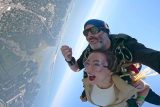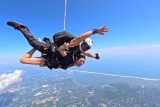Does Skydiving Feel Like Falling?
Skydiving
Posted by: Long Island Skydiving Center
2 years ago
People who have never been skydiving before often wonder: does skydiving feel like falling? It’s quite reasonable to think that it would, considering you’re hurling yourself out of an airplane and zooming towards the ground. But surprisingly, that’s not totally accurate! So, what does skydiving feel like? And how fast do you fall when skydiving?

These are two really great questions to ask when preparing yourself to jump out of an airplane for the first time. The average speed at which a skydiver falls is 120 mph – and it can get much faster than that depending on body position! This isn’t a speed that the human body is accustomed to traveling at, especially on its own. Of course we can’t fathom what skydiving feels like! (This brings up another question we get asked a lot: Does your stomach drop when you skydive? We’ll get to that later …)
Skydiving involves a lot of feelings and sensations that all add up to make it one of the most amazing and thrilling experiences available to us humans. Let’s have a look at a few important facts that will help you understand exactly what it feels like to jump into the big, beautiful Long Island sky.
Does Skydiving Feel Like Falling?
The short answer is: no. But, of course, it’s a little more complicated than that. You may think skydiving is all about adrenaline and excitement and risk taking, but there’s actually quite a bit of science behind the life of a daredevil.
It all starts with the exit from the airplane door. And we’re not just referring to the skydive. The forces that counteract the sensation of falling are in play before you even take that first step into the sky. It’s common to think that when you drop from the airplane, you’ll experience butterflies in your stomach like the kind you get on a rollercoaster. In fact, you won’t feel a flutter of a single flittery wing.
When you skydive from an airplane, you’re jumping out of a flying machine that’s moving forwards at around 100 mph – so instead of dropping straight down from the door, you’re actually flung forwards with the trajectory of the plane. You then gradually transition into vertical freefall over the first 10 seconds. Skydivers call this ‘the hill,’ because it has the path of a big arcing slope rather than a sheer drop.
And the rest is a piece of cake from there. Once you’re in freefall, you’ll feel your body relax into the freedom of flight. Your brain can’t comprehend the sheer magnitude of the speed and altitude you’re experiencing, and you’ll lack any nearby visual references that would trigger realization in your mind that you’re plummeting through the sky.
Your skydive will feel more like windy floating than falling, and you’ll truly understand what it feels like to experience human flight.
Exploring the Flying Sensation

Skydivers fly around the sky by assuming various body positions and movements that interact with the relative wind in different ways. This takes some practice, but by using their body, arms and legs to create angles, they can propel themselves in any direction they please. The best of the best even go on to achieve world records using highly refined body flying technique.
Flying your body like a pro takes a lot of time, effort, and practice to master, but you can start on your very first jump. Your tandem instructor will go over proper flying body position and explain how your body will interact with the relative wind. The first step is to fly stable, which is done by arching your body with your hips pressed down towards the ground and your head and legs pulled back. And if you go on to get your skydiving license, you’ll learn all the tips and tricks to master the art of falling with style!
The lack of falling sensation and the ability to seamlessly maneuver around in the sky really makes you feel like a bird or Superman. You’ll land from the jump feeling like you’ve gained superpowers. And in reality, you have! It might not be the ability to fly on a whim, but tackling the feat of going skydiving will leave you with boosted confidence, focused senses, and a new perspective on life.
Clarifying Misconceptions
Skydiving is full of misconceptions. It’s understandable – it’s impossible to really know what skydiving is like until you’ve done it for yourself. But all the misinformation swirling around certainly doesn’t help quell the nerves that come with jumping for the first time.
Rather than dropping out of the plane and hoping for the best like most people imagine, skydivers make a very controlled descent that is highly planned and practiced for. Every move is calculated from the location they exit the plane to the path they’ll fly to land. Skydivers do everything in their power to eliminate the unknown and mitigate the risk associated with jumping out of airplanes. There are even rules and regulations around the ways skydivers fly and what they’re allowed to do.
Another major misconception in skydiving is around people with a fear of heights. It’s completely logical to think that the higher you go, the scarier it would be for someone who is afraid of heights. And skydiving happens from high high. But, as it turns out, skydiving is so high that it doesn’t actually trigger a fear of heights. Because you are so high up that your brain can’t visually calculate the altitude, and because you feel as if you are flying rather than falling, you can enjoy your skydive even if you typically can’t get to the top of a ladder.

There’s so much more to skydiving than you can ever learn from the ground. So stretch those proverbial wings and come make a jump with us!
Categories:
You May Be Interested In:

Skydiving After LASIK: What You Need to Know
7 months ago by Long Island Skydiving Center

What Parachute Types Are There?
7 months ago by Long Island Skydiving Center

How Dangerous is Tandem Skydiving?
9 months ago by Long Island Skydiving Center

Nervous About Skydiving? Here Are Our Top 6 Tips!
9 months ago by Long Island Skydiving Center